Bulletin – March 2017 Payments Recent Trends in Banknote Counterfeiting
- Download 1.10MB
Abstract
Counterfeiting banknotes is a crime under Australian law. Although counterfeiting in Australia remains modest by international standards, the rate of counterfeiting has been rising in recent years as counterfeiters have increasingly taken advantage of developments in printing and copying. To ensure that counterfeiting remains low and banknotes remain a secure payment method, the Reserve Bank of Australia is issuing a new series of banknotes with upgraded security features.[1] This article discusses trends highlighted by the Reserve Bank's ongoing monitoring and analysis of banknote counterfeiting activity in Australia.
Introduction
Currency, defined here as banknotes and coins, plays an important role in the economy as a medium of exchange and a store of value. For Australia's currency to function efficiently, it is important that the public has confidence in it and is therefore willing to accept banknotes and coins in transactions. Counterfeiting currency is a crime under the Crimes (Currency) Act 1981, and carries penalties of up to 14 years' jail. People who fall victim to this crime have essentially been robbed. They cannot be reimbursed for their loss as, among other things, doing so would serve as an incentive to counterfeiters to continue their illegal activities. As a result, a high prevalence of counterfeiting can threaten public confidence in currency given that someone who accepts a counterfeit in place of a genuine banknote is left out of pocket and may be reluctant to accept banknotes in the future.
Under the Reserve Bank Act 1959, the Reserve Bank issues Australia's banknotes and has a mandate to contribute to the stability of the Australian currency. To ensure the security of these banknotes, the Reserve Bank works actively to monitor and manage the threat of banknote counterfeiting in Australia. The Reserve Bank works in partnership with key stakeholders to ensure that cash-handling professionals have information on how to detect counterfeits, that machines can authenticate banknotes, and that counterfeiters are apprehended and prosecuted (Evans, Gallagher and Martz 2015). The periodic issuance of new banknote series with upgraded security features, as is currently under way in Australia, is key to ensuring the security of, and thus confidence in, banknotes. Research into potential new security features is ongoing so that the Reserve Bank is well placed to develop and issue new banknote series as required and before counterfeiting levels become problematic. Monitoring of counterfeit activities informs the Bank's decisions about the timing of such issuance.
In the 1990s and early 2000s, the monitoring of counterfeit currency was largely conducted by Australian law enforcement agencies. While the Reserve Bank was able to directly monitor counterfeit banknotes detected during cash processing at Reserve Bank sites, these counterfeits were submitted to the Australian Federal Police. Counterfeits detected in other locations were handed directly to police. In 2009, the Reserve Bank established a centralised counterfeit examination laboratory. All counterfeits seized and detected in Australia now pass through this laboratory for detailed analysis. This provides the Reserve Bank with a more comprehensive understanding of the nature of counterfeiting across the country, enabling detailed assessments of the features and manufacturing methods used by counterfeiters. This article discusses some of the key results of this work.
Use of banknotes
There are currently around 1.5 billion Australian banknotes in circulation, worth almost $73 billion. The value of banknotes in circulation grew by around 6 per cent last year, in line with its long-term trend growth rate. This is also broadly in line with growth in the demand for cash seen internationally. In 123 economies for which data are readily available, the median growth of currency in circulation was around 9 per cent per annum for the four years to 2015, and around 6 per cent among advanced economies (Graph 1).

The results of the Reserve Bank's latest Consumer Payments Survey also indicate that currency remains an important payment method in Australia, with cash used in 37 per cent of transactions in 2016 (Doyle et al 2017). While electronic payment methods are now used in slightly more than half of the number of transactions, cash demand remains strong and it is likely that cash will remain an important part of the Australian payments system for the foreseeable future (Davies et al 2016).
Given the continued important role that cash plays in the economy, the Reserve Bank carefully monitors and analyses counterfeiting activity in Australia (and elsewhere) so it can take the necessary steps to ensure banknotes remain a safe and secure payment method.
Counterfeiting in Australia
Central banks must work closely with law enforcement authorities to monitor counterfeiting activity in order to determine how and when best to respond. This is complicated by the fact that it can take some time for counterfeits detected in circulation to reach central banks and law enforcement agencies, which can lead to delays in being able to accurately assess current counterfeiting levels.
Counterfeiting can be highly episodic in nature as counterfeiters ramp up their activities and law enforcement agencies respond. The increasing availability of high-quality, low-cost graphic reproduction technology has allowed criminals to be able to produce larger volumes of more sophisticated counterfeits (Fox, Liu and Martz 2016). However, to be able to then distribute these in large volumes typically requires some sort of organised distribution network.
Counterfeiting trends
The impetus for the introduction of polymer banknotes in Australia can be traced back to a counterfeiting incident in December 1966 when a number of high-quality counterfeits of the country's newly issued paper banknote series – regarded at the time as state of the art – began to circulate (Reserve Bank of Australia 2016). In response, the Reserve Bank established a ‘think tank’ with scientists from the Commonwealth Scientific and Industrial Research Organisation and tasked them with identifying innovative approaches to creating substantially more secure banknotes. A plastic-based substrate was proposed as a platform for a new generation of radically different security features, and the first Australian polymer banknote, a commemorative banknote, was issued in 1988.
The subsequent introduction of a full polymer series – a world first that was issued between 1992 and 1996 – proved to be timely. The early 1990s had seen the counterfeiting rate in Australia trending upwards, reaching 16 parts per million (ppm) in 1996, the year the final banknote in the new series was issued (Graph 2).[2],[3] Counterfeiting rates subsequently fell noticeably following the introduction of the first polymer series, before gradually starting to drift higher in the mid to late 2000s. The spikes in counterfeit detections in 2001–02, 2010, and 2014–15 reflect a small number of counterfeiting incidents where criminal groups produced and passed a large volume of counterfeits into circulation over a short time period. The Reserve Bank worked with the Australian Federal Police and other law enforcement agencies to shut down these production sources.
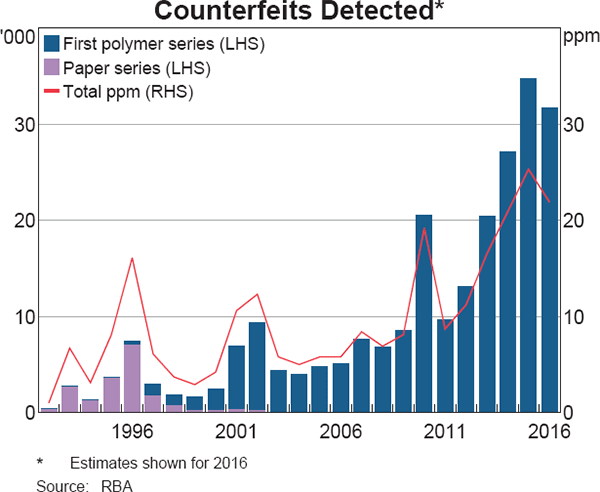
In May 2006, when most counterfeits were produced on paper, local authorities, working in conjunction with Interpol and the Australian Federal Police, intercepted a criminal operation in Colombia attempting to counterfeit the Australian $100 banknote and seized a number of printing materials, including partially printed counterfeits on plastic film (Kim and Turton 2014).[4] In response to gradually rising counterfeiting rates at the time, along with the evidence of polymer banknotes being counterfeited overseas, in 2007 the Bank established a program to issue a new series of banknotes that would incorporate cutting-edge anti-counterfeiting technologies to ensure banknotes remain secure against counterfeiting (Fox et al 2016; Kim and Turton 2014). The first denomination, the new $5 banknote, was issued into circulation on 1 September 2016. The Bank plans to issue roughly one denomination per year, with the $10 to be issued in September 2017. Issuance of the $50 banknote is planned for 2018.
The counterfeiting rate has continued to rise in recent years, albeit from relatively low levels, increasing by an average of 20 per cent per year over the past five years. In 2016, an estimated 31,682 counterfeit Australian banknotes, with a nominal face value of almost $1.8 million, were detected in circulation. This equates to a counterfeiting rate of 22 counterfeits per million banknotes in circulation.
It might be expected that the $100 would be the most counterfeited denomination because, on face value, it provides the greatest return to a counterfeiter. However, $100 banknotes are more likely to attract scrutiny given that they are not generally dispensed from automatic teller machines and do not circulate particularly widely. Rather, the $50 banknote is by far the most counterfeited denomination both in absolute terms and as a share of the volume of banknotes in circulation as it is more readily accepted and still offers a high return for the counterfeiter (Table 1).
Australian law enforcement agencies, and particularly the Australian Federal Police, are key partners in the management of the threat of counterfeit banknotes in Australia. Some counterfeits are seized by law enforcement agencies before they enter circulation, such as the counterfeits intercepted by Interpol and the Australian Federal Police in 2006. While seized counterfeits are not included in the statistics that are published – as counterfeits do not defraud people until they are passed into general circulation – they nevertheless represent a valuable contribution that law enforcement agencies make to protect the Australian public from counterfeiting. While in most years counterfeits detected in circulation far outweigh counterfeits seized, counterfeit seizures have accounted for around 35 per cent of identified counterfeits in some recent years (Graph 3).
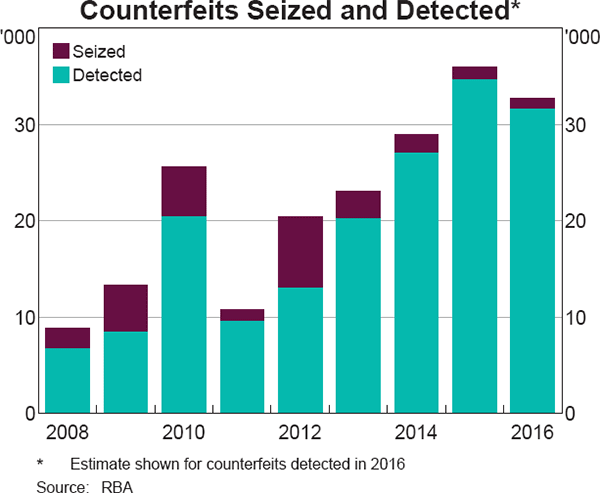
Manufacturing trends
In the 1990s, when Australia's first polymer banknote series was issued, technologies such as the internet, colour printing and digital imaging software were in their infancy (Adobe Systems Incorporated 2007). Today, these kinds of technologies are readily available and affordable. Data from the Australian Bureau of Statistics highlights the dramatic fall in the cost of audio, visual and computing equipment since the first polymer series was introduced, and how widespread access to the internet (and, by extension, computers and other internet-enabled devices) has become (Graph 4).
| $5 | $10 | $20 | $50 | $100 | Total | |
|---|---|---|---|---|---|---|
| Number | 31 | 66 | 466 | 26,486 | 4,632 | 31,682 |
| Nominal value ($) | 155 | 660 | 9,320 | 1,324,300 | 463,200 | 1,797,635 |
| Parts per million | <1 | 1 | 3 | 40 | 14 | 22 |
|
(a) Estimates are used to compensate for lags in counterfeit submissions to the Reserve Bank Source: RBA |
||||||
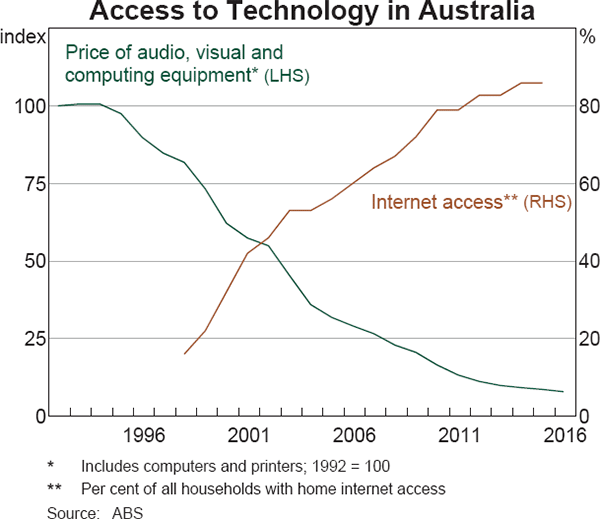
As a pioneer of polymer banknotes, Australia was able to take full advantage of the technical difficulty and expense of producing polymer counterfeits in the 1990s and 2000s. While the first recorded counterfeits on polymer were detected in 1997, they were printed using traditional, labour-intensive techniques. It was not until 2010 that polymer counterfeits began to appear to any noticeable extent when technological advancement enabled counterfeiters to more readily print larger volumes of counterfeits on plastic (Graph 5).
The increase in the volume of counterfeits on polymer has been associated with an increase in the quality, and thus deceptiveness, of counterfeits detected in Australia. While reasonable quality counterfeits that show evidence of more complex manufacturing techniques have been detected in increasing volumes, many are still poor-quality paper counterfeits that are produced with minimal effort. Over half of the counterfeits detected in 2016 were printed on polymer, while the rest were mainly the much poorer quality paper counterfeits.
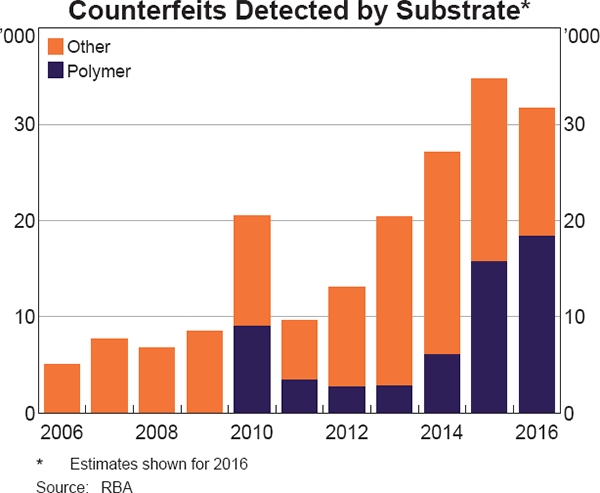
Comparison with fraud of other payment instruments
The direct cost of counterfeiting is low relative to fraud levels of other payment instruments in Australia (Graph 6). In the 2015/16 financial year, the nominal face value of counterfeits detected in circulation was around $1.7 million. This represents the direct cost borne by merchants or individuals who accepted the counterfeit banknotes for payment. By comparison, in the same period, around $24 million of fraudulent transactions were made using counterfeit or skimmed Australian-issued credit, debit and charge cards in Australia (APCA 2016). The annual value of counterfeit or skimmed card fraud has been consistently higher than the annual nominal face value of counterfeits detected since data on card fraud were first made available in 2006.
By contrast, the total cost of fraud committed using counterfeit cheques was similar to the value of counterfeit cash detected in circulation in 2015/16, at $1.8 million. The value of fraud committed using counterfeit cheques has declined since 2006. However, it is worth noting that cheques are used far less frequently than cash. It is estimated that in 2016, cheques accounted for as few as 0.2 per cent of transactions by volume, compared with 37 per cent for cash.
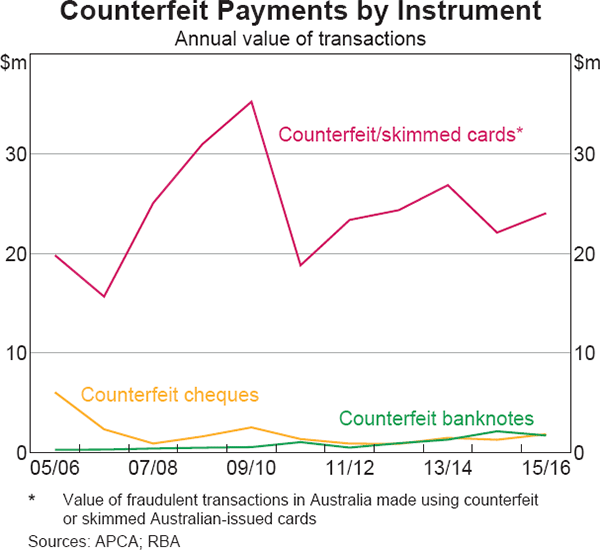
International Comparison
Overall, Australia's counterfeiting rate is relatively low compared with many other countries. In particular, Australia has avoided the high levels of counterfeiting that some other countries have experienced. Australia's counterfeiting rate peaked at 25 ppm in 2015 (Graph 7). By contrast, Brazil, Canada, Mexico and the United Kingdom have all reported counterfeiting rates in excess of 100 ppm in the last 15 years. Notably, Canada's counterfeiting rate reached a peak of 470 ppm in 2004 while the United Kingdom reached a peak of over 300 ppm in 2008. As a result, Canada issued a new series of banknotes between 2001 and 2006 and ‘aggressively withdrew’ the previous series, while the United Kingdom has issued the first denomination in a new series, with further denominations to be issued in coming years (Fung and Shao 2011). Both countries also made the move to polymer as part of their push to further enhance the security of their banknotes.
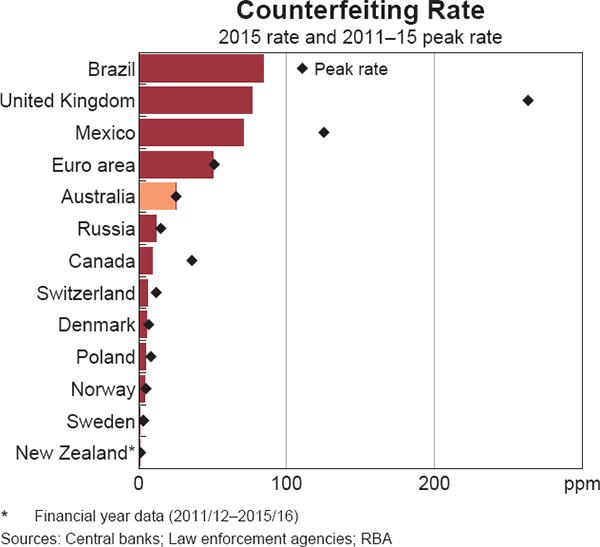
While counterfeiting rates in Australia have been rising, they have been falling in most other countries. Only four countries in the available sample have counterfeiting rates that rose in 2015: Australia, New Zealand, Norway and Sweden.[5] It is worth noting that the countries that have seen the biggest fall in counterfeiting rates (Brazil, the United Kingdom, Mexico and Canada) are the same countries that have reported counterfeiting rates over 100 ppm in the past 15 years. These large reductions are likely to reflect, at least in part, the result of activities undertaken by central banks and law enforcement agencies in response to these high rates.
It is relevant to note, however, that international comparisons of counterfeiting rates are not straightforward. Monitoring practices vary from country to country and so consistent data are difficult to obtain. It may also take considerable time for accurate figures to be published, as counterfeits will often be handled by many organisations before reaching the entity that collates and publishes the data. In addition, like other crime statistics, counterfeiting data may suffer some degree of under-reporting, as not all victims will report the crime to the relevant authorities, and some countries put more resources into counterfeit detection and recording than others (Levitt 1988).
Country-specific factors also play an important role in influencing counterfeiting rates. General socio-economic and institutional factors that affect economic crime rates more broadly, such as economic and political instability, the effectiveness of law enforcement agencies, entrenched organised criminal activity, or high poverty levels, may all affect counterfeiting rates (Buonanno 2003). Some countries use international currencies such as the US dollar or the euro alongside their local currency, and counterfeiters may prefer to target these international currencies (USDT, BGFRS and USSS 2006).
There is also likely to be a relationship between the age of a banknote series and counterfeiting rates of that series. There are two aspects to this: over time, technological advances make it easier to counterfeit the security features on the banknotes in circulation; and counterfeiters also learn how to better counterfeit these security features and refine their manufacturing techniques. Nevertheless, when the rate of counterfeiting of a country is considered relative to the age of its banknote series, Australia's counterfeiting rate is more closely aligned with countries experiencing low levels of counterfeiting (Graph 8).
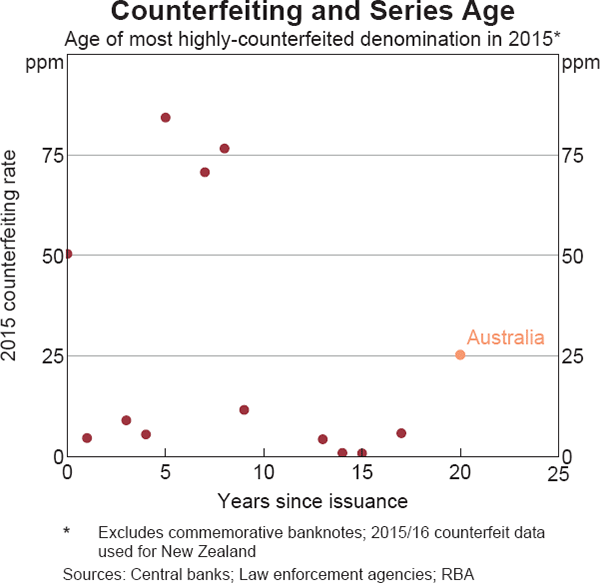
Conclusion
Cash remains a popular payment instrument in Australia and it is important to ensure that it remains secure and easy to use. The Reserve Bank carefully monitors counterfeiting activity in Australia and in other countries and constantly researches new security features. While improvements in copying technology have seen both the rate and quality of counterfeiting in Australia increase in recent years, it nevertheless remains low relative to the experience of many other countries.
It is necessary to upgrade Australian banknotes periodically to ensure they remain secure into the future. The monitoring and analysis of counterfeiting trends both in Australia and overseas allows the Reserve Bank to keep several steps ahead of counterfeiters by making improvements pre-emptively, before counterfeiting becomes a significant problem.
Footnotes
Shaun Collard and Morgan Spearritt are from Note Issue Department; Alexandra Brown is from Economic Analysis Department. This work was completed in Note Issue Department. This article draws on the expertise and work of staff in the Counterfeit Examination Laboratory. [*]
For information about the Reserve Bank's Next Generation Banknote Program see <http://banknotes.rba.gov.au/australias-banknotes/next-generation-banknotes-program/>. [1]
The Reserve Bank did not receive all counterfeits detected in circulation until 2009, so the counterfeiting data are less precise prior to this date. [2]
Counterfeiting rates are generally measured as ppm – the number of counterfeits detected per million genuine banknotes in circulation. [3]
These counterfeits are not included in Graph 2, as this graph shows only counterfeits detected in circulation, not counterfeits seized by police before they enter circulation. [4]
Sample based on countries that publicly release counterfeiting data. [5]
References
Adobe Systems Incorporated (2007), ‘History of Adobe’, Interactive Timeline, www.adobe.com site, viewed 24 February 2017. Available at <http://www.adobe.com/aboutadobe/history/timeline/index.html>.
APCA (Australian Payments Clearing Association) (2016), ‘Payment Fraud Statistics’, Fraud Statistics 2016 Financial Year Sheet.
Buonanno P (2003), ‘The Socioeconomic Determinants of Crime. A Review of the Literature’, University of Milano-Bicocca, Department of Economics Working Paper Series, No 63.
Davies C, M-A Doyle, C Fisher and S Nightingale (2016), ‘The Future of Cash’, RBA Bulletin, December, pp 43–52.
Doyle M-A, C Fisher, E Tellez and A Yadav (2017), ‘How Australians Pay: New Survey Evidence’, RBA Bulletin, March, p 59–66.
Evans A, G Gallagher and A Martz (2015), ‘Banknote Stakeholder Engagement’, RBA Bulletin, September, pp 1–11.
Fox P, C Liu and A Martz (2016), ‘New Banknotes: From Concept to Circulation’, RBA Bulletin, September, pp 1–11.
Fung B and E Shao (2011), ‘Modelling the Counterfeiting of Bank Notes: A Literature Review’, Bank of Canada Review, Autumn, pp 29–35.
Kim E and T Turton (2014), ‘The Next Generation Banknote Project’, RBA Bulletin, March, pp 1–11.
Levitt S (1988), ‘The Relationship Between Crime Reporting and Police: Implications for the Use of Uniform Crime Reports’, Journal of Quantitative Criminology, 14(1), pp 61–81.
Reserve Bank of Australia (2016), ‘Introducing Polymer Banknotes: 1988’, Reserve Bank of Australia Museum website, viewed 13 February 2017.
USDT, BGFRS and USSS (United States Department of the Treasury, Board of Governors of the Federal Reserve System and United States Secret Service) (2006), ‘The Use and Counterfeiting of United States Currency Abroad, Part 3’, The final report to the Congress by the Secretary of the Treasury, in consultation with the Advanced Counterfeit Deterrence Steering Committee, pursuant to Section 807 of PL 104-132, www.federalreserve.gov site, September. Available at <https://www.federalreserve.gov/boarddocs/RptCongress/counterfeit/counterfeit2006.pdf>.